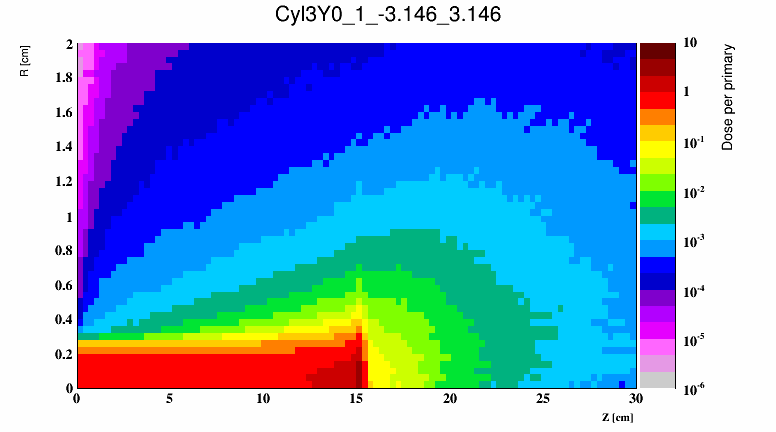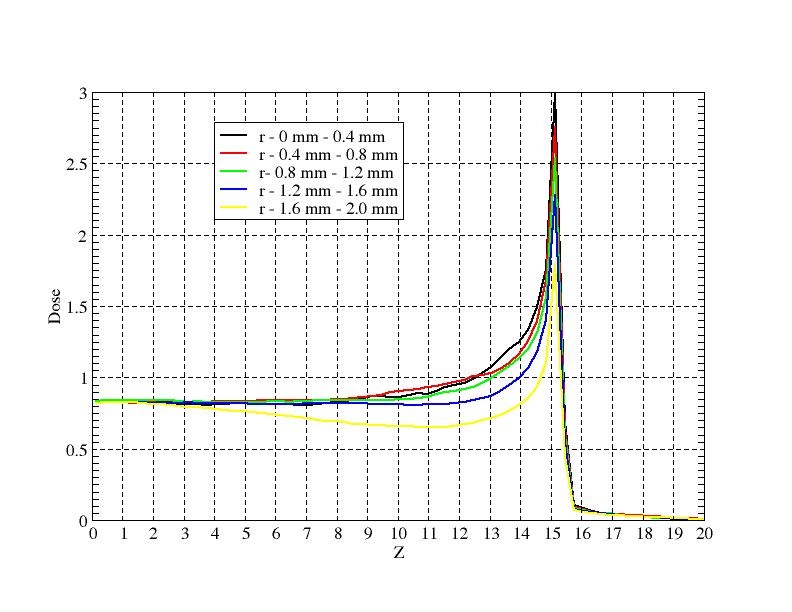Date: Fri, 24 Oct 2014 09:31:44 +0000
Dear Giuseppe,
I have modified your scoring (see attached input) and used a cylindrical binning to evaluate the dose (to keep the cylindrical symmetry it would be cleaner to use a cylindrical beam rather than a square one). If I make a single bin in phi here is what I obtained (see two D colour plot). If now I extract the different rings of the binning you see the value, looking at z = 1 cm the dose in the different bin seem rather similar and does not change much along z as you are in the plateau, so I am not sure there is such a dependency on the size of your scoring volume (at the edge of the beam spot there is one but it is clearly physical)...
Maybe you could do the calculations with a pencil beam. In a more general way, when scoring in small volume it is always good to look at the tips given in the following course material (ionization and transport) :
https://www.fluka.org/free_download/course/dresden2013/Lectures/14_Ionization_and_Transport_1013.pdf
with a convenient ionization transport cheat sheet....
Hoping this help
Regards
Joachim
From: owner-fluka-discuss_at_mi.infn.it [mailto:owner-fluka-discuss_at_mi.infn.it] On Behalf Of Giuseppe Prestopino
Sent: 10 October 2014 09:25
To: fluka-discuss_at_fluka.org
Subject: [fluka-discuss]: dose scoring in a thin volume
Dear FLUKA experts,
I need to simulate dosimetric properties of a solid state detector in high energy carbon and proton beams (energies typical of hadrontherapy application). Since the scoring volume is very thin, of the order of 1 - 3 microns (cylindrical shape, radius 1.1 mm), my first test was to check the constancy of scored dose by evaluating DOSE calculated by USRBIN per Region in a volume placed at the plateau of the depth dose curve and decreasing the volume thickness from 5 mm to 1 micron (radius 1.1 mm).
What I see is that the scored dose (calculated as dose by USRBIN per region divided by scoring volume) varies with scoring volume thickness, and that it is more pronounced for a beam that is not defined as a pencil beam (I considered a square beam). Relative deviation of the thin volumes (1-3 um) I am interested to, with respect dose value for thicker volumes, is too high. I have attached my input file (executable "test" is compiled linking to "ldpmqmd") and my simulation results (10000 primaries x 3 cycles for the square field, and 3000 primaries x 3 cycles for the pencil beam).
Please, give me some idea for reducing such effect..
Best regards,
Giuseppe
- application/octet-stream attachment: carbon.inp

(image/png attachment: Cyl3Y0_1_-3.146_3.146.png)

(image/jpeg attachment: doserings.jpg)